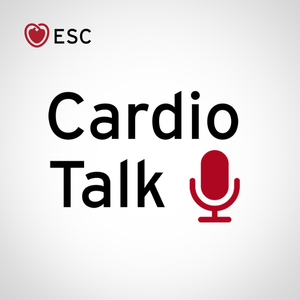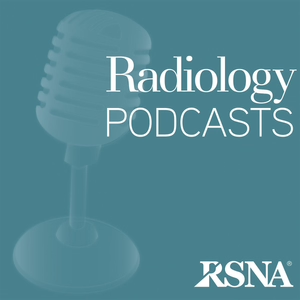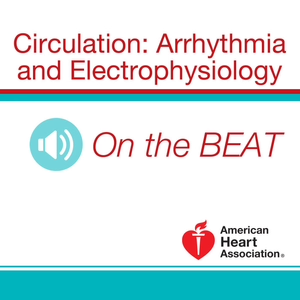
Circulation: Arrhythmia and Electrophysiology January 2020 Issue
04/03/20 • 16 min
Paul J. Wang: Welcome to the monthly podcast On the Beat, for Circulation: Arrhythmia and Electrophysiology. I'm Dr Paul Wang, editor in chief with some of the key highlights from this month's issue.
In our first paper in the real time mapping of AF drivers RADAR study, Subbarao Choudry and associates examined in a single arm first in human investigator-initiated FDA IDE study, a novel system for real time, high resolution identification of atrial fibrillation, AF drivers, in persistent or long-standing persistent AF. They enrolled 64 subjects at four centers, 73% male age, 64.7 years, BMI 31.7. LA size 54. Longstanding AF, 83% longstanding persistent, 17%. prior AF ablation, 41%. After 12.6 months of follow-up, 68% remained AF free off all antiarrhythmics. 74% remained AF free and 66% remained AF, AT and A-flutter free on or off antiarrhythmic drugs. AF terminated with atrial fibrillation ablation in 35 patients, 55% overall. And in 23 out of 38, 61% of de novo ablation patients. For patients with AF termination during atrial ablation, 82% remained AF free and 74% AF, AT or A-flutter free during follow-up on or off antiarrhythmic drugs. Patients undergoing first time AFib ablation had higher rates of freedom from AF than the redo group.
In our next paper, David Briceño and associates examined 19 consecutive patients presenting with left bundle branch block ventricular tachycardia in the setting of arrhythmogenic right ventricular cardiomyopathy, ARVC, with procedures separated by at least nine months and a mean of 50 months. The authors found there was no significant progression of voltage bipolar 38 centimeters squared versus 53 centimeters squared, p=0.09 or unipolar 116 centimeters squared versus 159 centimeters squared, p=0.36 for the entire group. There was a significant increase in right ventricular RV volumes, percentage increase 28%. 206 milliliters versus 263 milliliters, P less than 0.001 for the entire study population. Larger scars at baseline but not changes over time were associated with a significant increase in RV volume, p=0.006 for bipolar and p=0.03 for unipolar.
Most patients with progressive RV dilatation, 57%, had moderate in two patients or severe in six patients, tricuspid regurgitation recorded either at initial or repeat ablation procedure. The authors found that in patients with ARVC presenting with recurrent ventricular tachycardia, more than 10% increase in right ventricular endocardial surface area of bipolar voltages consistent with scar is uncommon during intermediate follow-up. Most recurrent ventricular tachycardias are localized to regions of prior defined scar.
In our next paper, Susan Heckbert and associates examined detection of atrial fibrillation in 1,556 individuals participating in an ancillary study involving ambulatory ECG monitoring part of the cross-sectional analysis in the multiethnic study of atherosclerosis, MESA, a community based cohort study that enrolled 6,814 Americans free of clinically recognized cardiovascular disease in 2000 to 2002. Among 1,556 participants, 41% were white, 25% African American, 21% Hispanic, 14% Chinese, 51% were women mean age 74 years. The prevalence of clinically detected atrial fibrillation after 14.4 years follow-up was 11.3% in whites, 6.6% in African Americans, 7.8% in Hispanics and 9.9% in Chinese and was significantly lower in African Americans than in whites in both unadjusted and risk factor adjusted analyses, p less than 0.001. By contrast, in the same individuals, the proportion of monitor detected atrial fibrillation using a 14-day ambulatory ECG monitor was similar in the four race or ethnic groups. 7.1%, 6.4%, 6.9% and 5.2% compared with white, all p greater than 0.5.
The authors concluded that the prevalence of clinically detected atrial fibrillation was substantially lower in African Americans than white participants with or without adjustments for atrial fibrillation risk factors. However, unbiased atrial fibrillation detection by ambulatory monitoring the same individuals reveal little difference in the proportion with atrial fibrillation by race, ethnicity, supporting the hypothesis of differential detection by race, ethnicity in the clinical recognition of atrial fibrillation.
In our next paper, Maria Teresa Barrio-Lopez and associates examined the presence of epicardial connections between pulmonary veins and other anatomical structures. The authors considered an epicardial connection was present if one, the first pass around the pulmonary vein antrum did not produce pulmonary vein isolation. And two, subsequent atrial activation during pulmonary vein pacing showed that the earliest site was located away from the ablation line and later activation sites were obscured near the ablation line.
Out of the 534 patients included, 72 or 13.5%, were found to have 81 epicardial connections. There was a significant association between the presence of epicardial...
Paul J. Wang: Welcome to the monthly podcast On the Beat, for Circulation: Arrhythmia and Electrophysiology. I'm Dr Paul Wang, editor in chief with some of the key highlights from this month's issue.
In our first paper in the real time mapping of AF drivers RADAR study, Subbarao Choudry and associates examined in a single arm first in human investigator-initiated FDA IDE study, a novel system for real time, high resolution identification of atrial fibrillation, AF drivers, in persistent or long-standing persistent AF. They enrolled 64 subjects at four centers, 73% male age, 64.7 years, BMI 31.7. LA size 54. Longstanding AF, 83% longstanding persistent, 17%. prior AF ablation, 41%. After 12.6 months of follow-up, 68% remained AF free off all antiarrhythmics. 74% remained AF free and 66% remained AF, AT and A-flutter free on or off antiarrhythmic drugs. AF terminated with atrial fibrillation ablation in 35 patients, 55% overall. And in 23 out of 38, 61% of de novo ablation patients. For patients with AF termination during atrial ablation, 82% remained AF free and 74% AF, AT or A-flutter free during follow-up on or off antiarrhythmic drugs. Patients undergoing first time AFib ablation had higher rates of freedom from AF than the redo group.
In our next paper, David Briceño and associates examined 19 consecutive patients presenting with left bundle branch block ventricular tachycardia in the setting of arrhythmogenic right ventricular cardiomyopathy, ARVC, with procedures separated by at least nine months and a mean of 50 months. The authors found there was no significant progression of voltage bipolar 38 centimeters squared versus 53 centimeters squared, p=0.09 or unipolar 116 centimeters squared versus 159 centimeters squared, p=0.36 for the entire group. There was a significant increase in right ventricular RV volumes, percentage increase 28%. 206 milliliters versus 263 milliliters, P less than 0.001 for the entire study population. Larger scars at baseline but not changes over time were associated with a significant increase in RV volume, p=0.006 for bipolar and p=0.03 for unipolar.
Most patients with progressive RV dilatation, 57%, had moderate in two patients or severe in six patients, tricuspid regurgitation recorded either at initial or repeat ablation procedure. The authors found that in patients with ARVC presenting with recurrent ventricular tachycardia, more than 10% increase in right ventricular endocardial surface area of bipolar voltages consistent with scar is uncommon during intermediate follow-up. Most recurrent ventricular tachycardias are localized to regions of prior defined scar.
In our next paper, Susan Heckbert and associates examined detection of atrial fibrillation in 1,556 individuals participating in an ancillary study involving ambulatory ECG monitoring part of the cross-sectional analysis in the multiethnic study of atherosclerosis, MESA, a community based cohort study that enrolled 6,814 Americans free of clinically recognized cardiovascular disease in 2000 to 2002. Among 1,556 participants, 41% were white, 25% African American, 21% Hispanic, 14% Chinese, 51% were women mean age 74 years. The prevalence of clinically detected atrial fibrillation after 14.4 years follow-up was 11.3% in whites, 6.6% in African Americans, 7.8% in Hispanics and 9.9% in Chinese and was significantly lower in African Americans than in whites in both unadjusted and risk factor adjusted analyses, p less than 0.001. By contrast, in the same individuals, the proportion of monitor detected atrial fibrillation using a 14-day ambulatory ECG monitor was similar in the four race or ethnic groups. 7.1%, 6.4%, 6.9% and 5.2% compared with white, all p greater than 0.5.
The authors concluded that the prevalence of clinically detected atrial fibrillation was substantially lower in African Americans than white participants with or without adjustments for atrial fibrillation risk factors. However, unbiased atrial fibrillation detection by ambulatory monitoring the same individuals reveal little difference in the proportion with atrial fibrillation by race, ethnicity, supporting the hypothesis of differential detection by race, ethnicity in the clinical recognition of atrial fibrillation.
In our next paper, Maria Teresa Barrio-Lopez and associates examined the presence of epicardial connections between pulmonary veins and other anatomical structures. The authors considered an epicardial connection was present if one, the first pass around the pulmonary vein antrum did not produce pulmonary vein isolation. And two, subsequent atrial activation during pulmonary vein pacing showed that the earliest site was located away from the ablation line and later activation sites were obscured near the ablation line.
Out of the 534 patients included, 72 or 13.5%, were found to have 81 epicardial connections. There was a significant association between the presence of epicardial...
Previous Episode
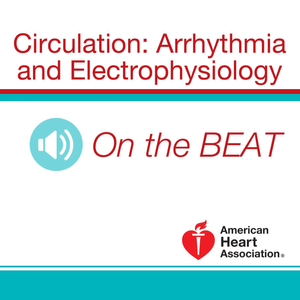
Circulation: Arrhythmia and Electrophysiology December 2019 Issue
Paul J. Wang: Welcome to the monthly podcast On the Beat for Circulation: Arrhythmia and Electrophysiology. I'm Dr Paul Wang, Editor-in-Chief with some of the key highlights from this month's issue.
In our first paper, Jacob Koruth and Associates examine the ability to produce ablation lesions using pulse field ablation, which is tissue specific and non-thermal in swine compared to radio frequency ablation. All 46 targeted veins were successfully isolated on the first attempt in all cohorts. Pulmonary vein isolation durability was assessed in 28 veins, including the SVC. Durability was higher in the pulsed field ablation bipolar group, 18 out of 20 in the bipolar group, 10 out of 18 in the monopolar group, and 3 out of 6 in the radio frequency group. P = 0.002. Transmit morality rates were similar across groups with evidence of nerve damage only with radiofrequency.
In our next paper, Vivek Reddy and Associates is part of the multicentered first-in-human study, RADIANCE, examine the ability of a novel compliant radio frequency balloon catheter with 10 irrigated flexible electrodes to simultaneously and independently deliver energy. At four sites, 39 patients with paroxysmal atrial fibrillation underwent pulmonary vein isolation using energy delivery simultaneously from all electrodes up to 30 seconds posteriorly, and 60 seconds anteriorly. 152 of 152 targeted pulmonary veins were isolated. 79.6% with a single application. Electrical reconnection occurred in only 7 out of 150 pulmonary veins or 4.7% upon adenosine isoproterenol challenge. Esophageal temperature was monitored in all patients. The esophagus was also mechanically deviated in ten patients. At three months, imaging revealed no pulmonary vein stenosis and early atrial recurrence occurred in only 10 out of 39 or 25.6% of patients.
In our next paper Takeshi Kitamura and Associates examine the effect of substrate based ventricular tachycardia ablation targeting local abnormal ventricular activity on recurrent ventricular fibrillation events in patients with structural heart disease. In a retrospective two center study of a total of 686 patients with incident ventricular tachycardia ablation procedure targeting local abnormal ventricular activity, 21 patients, age 57 years left ventricular ejection fraction 30%, had both ventricular tachycardia and ventricular fibrillation.
A total of 80 ventricular fibrillation events were recorded in the ICD logs, the six months preceding ablation. Complete and partial local abnormal ventricular activity elimination was achieved in 11 or 52%, in 10 or 58% of patients respectively. Catheter ablation was associated with a highly significant reduction in ventricular fibrillation recurrences. P less than 0.0001 which were limited to three or 14 patients at six months. The total number of ventricular events therefore, decreased from 80 to three with a median of 1.0 to 0.0 in the six months prior to and following ablation respectively.
The reduction in ventricular fibrillation events was significantly greater in patients with catheter ablation compared to 21 match controls during a 6- month period preceding and following a baseline assessment. The authors concluded that substrate guided ventricular tachycardia ablation, targeting local abnormal ventricular activity, may be associated with a significant reduction in recurrent ventricular fibrillation, suggesting that ventricular tachycardia and ventricular fibrillation share overlapping arrhythmogenic substrate in patients with structural heart disease.
In our next paper, Feng Hu and Associates examine the effect of right anterior ganglion aided plexi ablation on vagal response during circumferential pulmonary vein isolation. 80 patients with paroxysmal atrial fibrillation who underwent first time ablation were prospectively enrolled and randomly assigned to two groups. Group A (n = 40) circumferential pulmonary vein isolation starting with the right pulmonary veins at the right anterior ganglion plexi site. In group B (n = 40) circumferential pulmonary vein isolation starting with the left pulmonary veins first, and the last ablation site being the right anterior ganglionic plexi site.
During circumferential pulmonary vein isolation, the positive vagal response was observed in only one patient in group A, in 25 patients in group B. P less than 0.001. A total of 21 patients with positive vagal response in group B needed temporary ventricular pacing during the procedure, while the only patient with positive vagal response in group A did not need temporary ventricular pacing, P less than 0.001. Compared with baseline basic cycle length, sinus node recovery time, and AV node Wenckebach pacing cycle length were decreased significantly after pulmonary vein isolation procedure in both groups, all P less than 0.05 and without differences between the two groups.
In our next paper, Karl-Heinz Kuck and Associat...
Next Episode
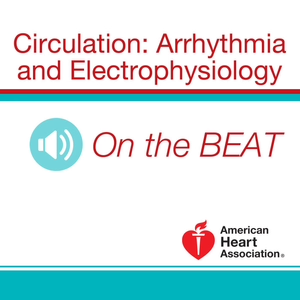
Circulation: Arrhythmia and Electrophysiology February 2020 Issue
Paul J. Wang: Welcome to the monthly podcast On the Beat for Circulation: Arrhythmia and Electrophysiology. I'm Dr Paul Wang, editor in chief, with some of the key highlights from this month's issue.
In our first paper, Ling Kuo and associates examine the association between left atrial high-resolution late gadolinium enhancement on cardiac magnetic resonance and electrogram abnormalities in patients with atrial fibrillation or AF. They found that in 40 AF patients age 63.2 years with a mean of 1312 electrogram points per patient. Lower bipolar voltage was associated with higher signal intensity Z score in patients who had undergone previous ablation coefficient equals -0.049 P < 0.001 but not in ablation-naive patients, coefficient = -0.004, P = 0.7. Left atrial high-resolution late gadolinium enhancement activation delay was associated with signal intensity z-score in patients with previous ablation, signal intensity Z score coefficient = 0.004, P < 0.001 but not in ablation-naive patients. In contrast, increased left atrial high-resolution late gadolinium enhancement fractionation was associated with signal intensity z-score coefficient 0.012, P = 0.03, and left atrial high-resolution late gadolinium enhancement coefficient 0.035, P < 0.001 only in ablation-naive patients.
The authors concluded that the association of left atrial late gadolinium enhancement with voltage is modified by ablation in ablation naive patients. Atrial late gadolinium enhancement is associated with electrogram fractionation even in the absence of voltage abnormality.
In our next paper, Laila Staerk and associates examine the associations between 85 protein biomarkers and incident atrial fibrillation or AF in patients 50 years of age or greater, from the Framingham Heart Study Offspring and Third Generation cohorts. Out of 3378 participants, 54% women, mean age 61.5 years, 401 developed AAF over a mean follow-up of 12.3 years. They observed a lower hazard of incident atrial fibrillation associated with mean higher levels of incident like growth factor hazard ratio per one standard deviation increment in protein level equals 0.84, and higher hazard ratio of incident atrial fibrillation associated with higher mean levels of both insulin-like growth factor-binding protein and N-terminal pro-B-hormone type a natriuretic peptide.
In our next paper, Eoin Donnellan and associates examine changes in atrial fibrillation or AF type following bariatric surgery in 220 morbidly obese patients body mass index ≥40 kilograms per meter square. They observed a reduction in body mass index following bariatric surgery from 49.7 to 37.2 kilograms per meter square. Weight loss was greatest in the gastric bypass group with a mean percentage loss of 25% compared to 19% in patients underwent sleeve gastrectomy, and 16% following gastric banding. P < 0.0001 reversal of AF type occurred in 71% of patients following gastric bypass, 56% of patients who underwent sleeve gastrectomy and 50% of patients following gastric banding, P = 0.004. They found that on Cox proportional hazards analysis percent weight loss was significantly associated with AFib reversal, P = 0.0002.
In our next paper, Thomas Pezawas and associates examine the role of diastolic function assessment to predict arrhythmic death.
They prospectively enrolled 120 patients with ischemic, 60 patients with dilated cardiomyopathy, and 30 patients with normal left ventricular ejection fraction. After an average of 7.0 years, arrhythmic death or resuscitated cardiac arrest was observed in 28 (or 13.3%) and 33 (or 15.7%) of patients respectively. Non-arrhythmic death was found in 41 (or 19.5%) of patients. On Kaplan Meier analysis patients with dysfunction grade III had the highest risk of arrhythmic death or resuscitated cardiac arrest, P < 0.001.
This finding was independent from the degree of left ventricular ejection fraction and was observed in patients with ejection fraction ≤ 35%, P = 0.001 and with a left ejection fraction > 35%, P = 0.014. Non-arrhythmic mortality was highest and patients with dysfunction grade III. This was true for patients with left ventricular ejection fraction ≤to 35%, or > 35%. In an adjusted model for relevant confounding factors, grade III dysfunction was associated with a 3.5-fold, increased risk of arrhythmic death or resuscitated cardiac arrest in the overall study population hazard ratio of 3.52, P < 0.001.
In our next paper, because asthma and atrial fibrillation share an underlying inflammatory pathophysiology, Matthew Tattersall and associates hypothesize that persistent asthmatics would be at higher risk for developing atrial fibrillation or AF and this association would it be attenuated by adjust for baseline markers of systemic inflammation.
The authors exa...
If you like this episode you’ll love
Episode Comments
Generate a badge
Get a badge for your website that links back to this episode
<a href="https://goodpods.com/podcasts/circulation-arrhythmia-and-electrophysiology-on-the-beat-94401/circulation-arrhythmia-and-electrophysiology-january-2020-issue-5066042"> <img src="https://storage.googleapis.com/goodpods-images-bucket/badges/generic-badge-1.svg" alt="listen to circulation: arrhythmia and electrophysiology january 2020 issue on goodpods" style="width: 225px" /> </a>
Copy

